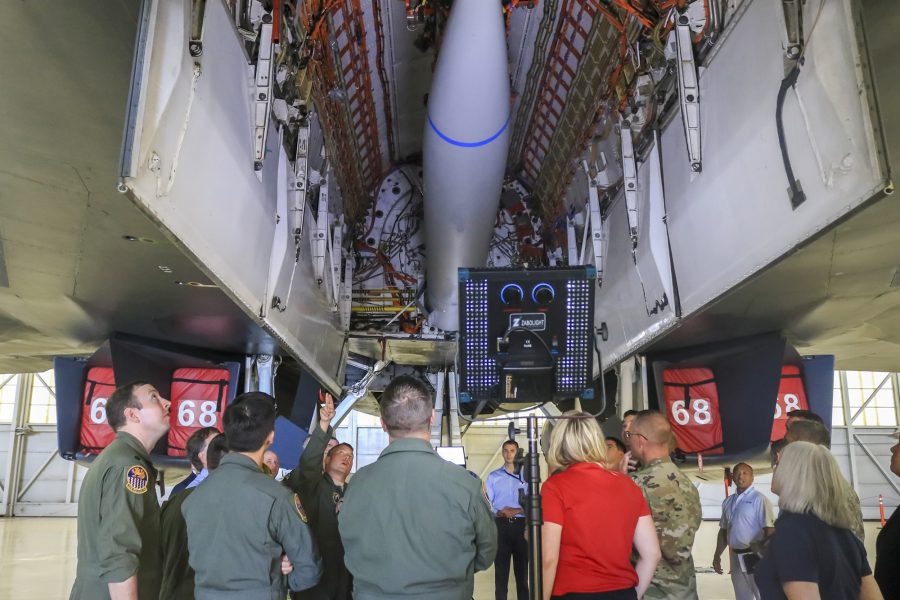Global Strike Command is planning to put the hypersonic AGM-183 Air-launched Rapid Response Weapon externally on the B-1 bomber, and AFGSC chief Gen. Timothy Ray said he sees a conventional version of the Long-Range Stand-Off weapon as a sensible approach to replacing the conventional Air-Launched Cruise Missile if a weapon with longer range than the JASSM-ER is required.
Ray, in an interview that will appear in the May issue of Air Force Magazine, said he wants to refurbish and modernize the remaining B-1B aircraft after the Air Force retires 17 airframes from the fleet. That modification would include opening up eight external hardpoints on the bomber’s fuselage that were originally planned to carry two ALCMS each; subsequent treaty agreements took the B-1 out of the nuclear mission and the hardpoints were covered over.
“My goal would be to bring on at least a squadron’s worth of airplanes modified with external pylons on the B-1, to carry the ARRW hypersonic cruise missile,” Ray said. A B-1 squadron typically has 18 aircraft.
The 412th test wing at Edwards AFB, Calif., demonstrated additional B-1 carriage options last August, including the use of external hardpoints, as well as expanded internal bays and use of the Common Strategic Rotary Launcher with the stealthy, conventional JASSM-ER.
Some airplanes “will need significant structural work,” Ray said. “We can do smart things, and we’ve got support from Congress to do this. This is a thing that we’re working to get ourselves through. We’ve had a very good dialog.”
Modifying the B-1s to carry the ARRW was not an item requested in the fiscal 2021 budget, Ray said, but it’s “a project we’re working on. There are several versions that we could contemplate, but we believe the easiest, fastest, and probably most effective in the short term will be to go with the external pylons.” The ARRW, he said, is “a good weapon airframe and configuration match to get us quickly into that game.”
Asked if AFGSC’s preference is for ARRW versus other hypersonic missiles, Ray said, “I think we’re going to commit to the ARRW, because I think our carriage capability is good for that.”
The Air Force is also working on the Hypersonic Air-breathing weapon Concept, or HAWC, with the Defense Advanced Research Projects Agency. Pentagon officials said the Air Force has been thinking about mixed carriage of hypersonic missiles both internally and externally, on the B-1 and B-52. Using the external hardpoints and the CSRL, a B-1 could conceivably carry 31 hypersonic missiles.
Ray said the B-52 fleet also will be configured for hypersonic missiles, and because that airframe will have new engines, radar, communications, and weapons, the plan now is to increase the bomber test fleet from two to eight aircraft at Edwards. The B-1 will be able to take some of the “load off the B-52” in hypersonic missile testing, he said. The test program, which was developed in coordination with Air Force Materiel Command, is “very aggressive” and will required USAF “to commit more aircraft, and maintainers, and operators” to test over the next three-to-five years, Ray said.
“The bomber world has been very good about combining and integrating operational and developmental test and leveraging the number of resources. And this was a conversation with [AFMC] … that we came to this solution set.”
Ray said AFGSC has not set a requirement for a conventional version of LRSO to mirror the ALCM/Conventional ALCM USAF has operated for the last 30 years, but that such a weapon would be a logical approach if a weapon with longer range is needed.
“First things first: the ALCM is aging out on us,” and must be replaced, he said. But, “I’ve shot CALCM in anger…the utility of those is unquestionable.” He’s pleased with how LRSO is progressing—“I think that’s going to be a very, very good missile”—and if there was a sudden requirement for “an even longer-ranged cruise missile with conventional capability,” LRSO would be the place to start. However, Ray noted that changes to the program have to happen “within a treaty context.”
“Right now, we’re not asking for that, based on the prioritization of the nuclear piece, … but there’s things that could change in the future.”
